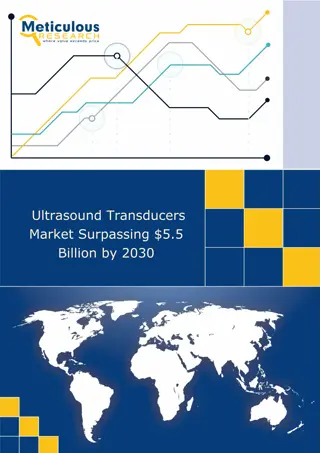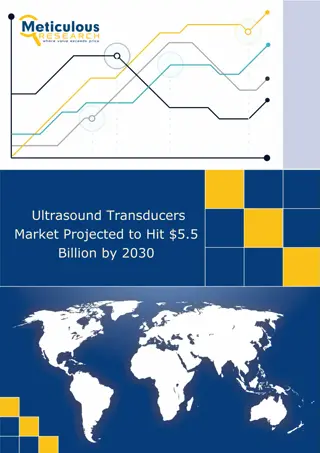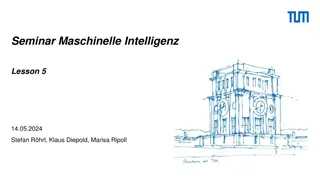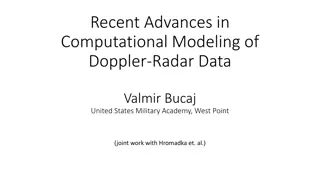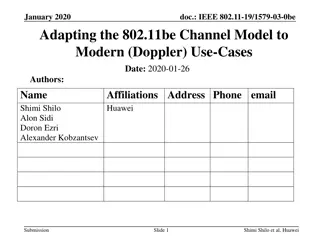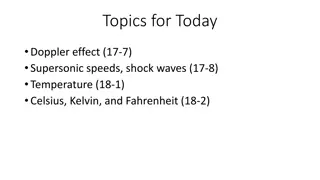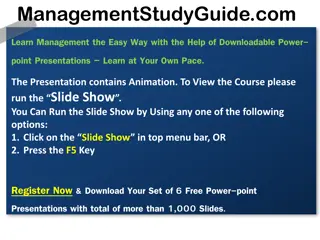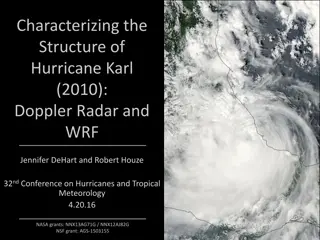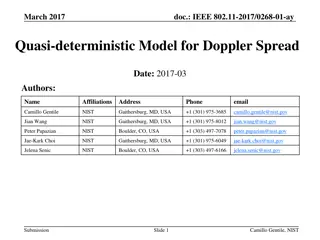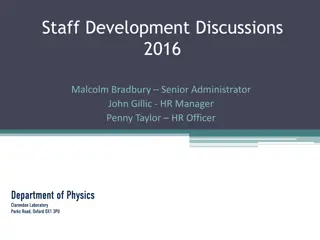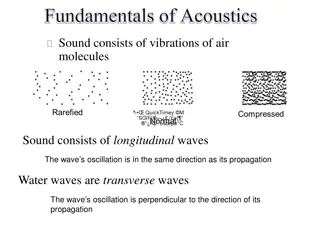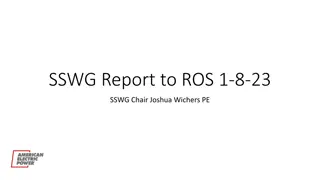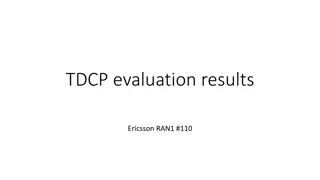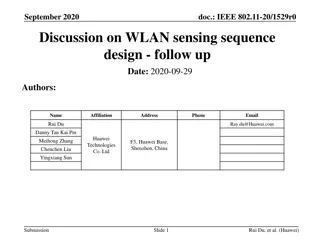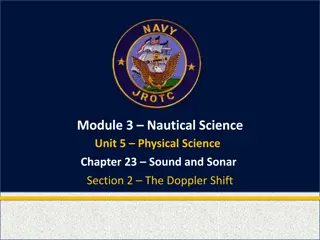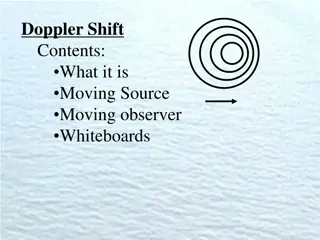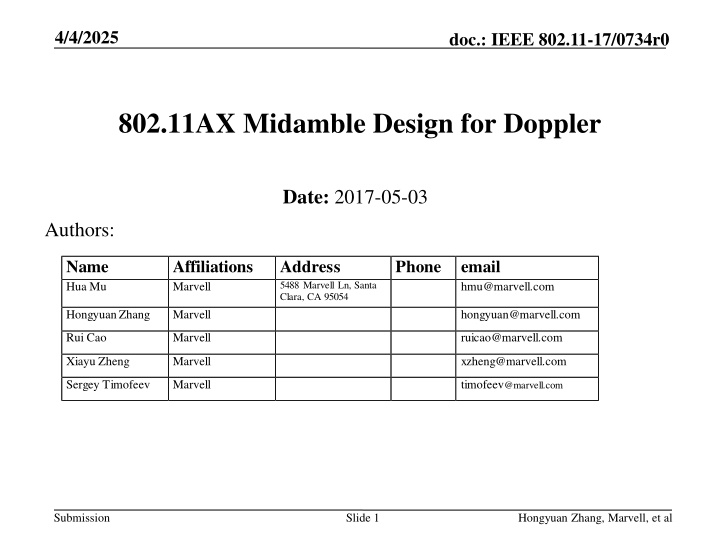
Midamble Design for Doppler in IEEE 802.11ax
Explore the innovative midamble design proposed by Marvell for combating outdoor channel variations in IEEE 802.11-17/0734r0. Learn about the implications on PHY design, pilot options, and midamble structure in the context of 11ax and 11ah standards. Discover how midamble offers advantages over traveling pilots in terms of simplicity, performance, and adaptability to high Doppler channels.
Download Presentation

Please find below an Image/Link to download the presentation.
The content on the website is provided AS IS for your information and personal use only. It may not be sold, licensed, or shared on other websites without obtaining consent from the author. If you encounter any issues during the download, it is possible that the publisher has removed the file from their server.
You are allowed to download the files provided on this website for personal or commercial use, subject to the condition that they are used lawfully. All files are the property of their respective owners.
The content on the website is provided AS IS for your information and personal use only. It may not be sold, licensed, or shared on other websites without obtaining consent from the author.
E N D
Presentation Transcript
4/4/2025 doc.: IEEE 802.11-17/0734r0 802.11AX Midamble Design for Doppler Date: 2017-05-03 Authors: Name Hua Mu Affiliations Marvell Address 5488 Marvell Ln, Santa Clara, CA 95054 Phone email hmu@marvell.com hongyuan@marvell.com Hongyuan Zhang Marvell Rui Cao Marvell ruicao@marvell.com Xiayu Zheng Marvell xzheng@marvell.com Sergey Timofeev Marvell timofeev@marvell.com Submission Slide 1 Hongyuan Zhang, Marvell, et al
4/4/2025 doc.: IEEE 802.11-17/0734r0 Introduction In 11ax D1.0, HE-SIG-A in 11ax HE SU, HE SU Ext, HE MU PPDU has reserved one Doppler bit. By setting Doppler bit to 1, we propose a midamble design to combat the outdoor channel variations Insert a midambe every M DATA OFDM symbols A midamble contains one or more HE-LTFs, and possibly an HE-STF. Discuss PHY design details: midabmle periodicity, HE-STF, HE-LTF, etc Submission Slide 2 Hongyuan Zhang, Marvell, et al
4/4/2025 doc.: IEEE 802.11-17/0734r0 Midamble vs Travelling Pilots (11ah) Midamble incurs simpler design than travelling pilots. Quicker market adoption Better performance than Travelling Pilots: Able to handle larger Doppler by adjusting periodicity On the other hand: 11ax pilots were intentionally made scarcer for better efficiency, therefore channel est update by Travelling Pilots is much slower or not suitable for outdoor channels if using tone decimation. 20MHz: 30 symbols to brute force, 80MHz: 62 symbols to brute force Able to handle power changes better if midamble contains HE-STF field. Able to support much higher data rates: more spatial streams, and wider BW. High Doppler Channel Low Data rate. Extendable to more aggressive environments in the future, e.g. automotive. Submission Slide 3 Hongyuan Zhang, Marvell, et al
4/4/2025 doc.: IEEE 802.11-17/0734r0 Midamble Design Preamble DATA_1 DATA_2 DATA_k Midamble Midamble M data symbols M data symbols M data symbols HESTF HELTF1 HELTFN Insert a midamble every M DATA OFDM symbols Coding/scrambling not disrupted by midambles i.e. same as no midamble cases. Submission Slide 4 Hongyuan Zhang, Marvell, et al
4/4/2025 doc.: IEEE 802.11-17/0734r0 Midamble Structure (1) A midamble includes one or more HE-LTF field A midamble may or may not include a HE-STF field, power variations are typically too small to incur AGC gain changes Option 1: the HE-STF in midmable can be a full length 4us HE-STF, the same as in preamble Option 2: Shorter HE-STF in midmable than in preamble, e.g. two 0.8us periods Option 3: No HE-STF in midamble. Option 1 Full length HE-STF HE-LTF(s) Option 2 Fig. 2 Midamble Structure Shorter HE-STF HE-LTF(s) Option 3 HE-LTF(s) Submission Slide 5 Hongyuan Zhang, Marvell, et al
4/4/2025 doc.: IEEE 802.11-17/0734r0 Midamble Structure (2) HE-LTF compression rate (1x, 2x, 4x) in midamble may be identical to that in preamble. No additional HE-SIG field signaling needed. 1x HELTF in midamble may be preferred if channel delay is short reduce overhead significantly, refer to sims later. Submission Slide 6 Hongyuan Zhang, Marvell, et al
4/4/2025 doc.: IEEE 802.11-17/0734r0 Simulation Setup Midamble insertion is considered overhead. So we choose Goodput as performance metric. Goodput is calculated as Data rate (1-PER) midamble efficiency Simulation is based on both UMi-LOS and DNLOS channel model with pedestrian mobility (the aggressive model in [1]), 20MHz, LDPC, data length 64Kb. UMi-LOS: 60kmph on 2nd and 3rd clusters, 3kmph on all other clusters [1] DNLOS: 3 clusters, speed [3kmph, 60kmph, 3kmph] Both 1SS and 2SS cases are simulated Goodput shown in next slides Example PERs in Appendix Submission Slide 7 Hongyuan Zhang, Marvell, et al
4/4/2025 doc.: IEEE 802.11-17/0734r0 Goodput, UMi-LOS, 4xLTF Submission Slide 8 Hongyuan Zhang, Marvell, et al
4/4/2025 doc.: IEEE 802.11-17/0734r0 Goodput, DNLOS, 4xLTF Submission Slide 9 Hongyuan Zhang, Marvell, et al
4/4/2025 doc.: IEEE 802.11-17/0734r0 Goodput, DNLOS, 1xLTF Submission Slide 10 Hongyuan Zhang, Marvell, et al
4/4/2025 doc.: IEEE 802.11-17/0734r0 Discussions on Goodput results 2ss transmission outperforms 1ss in terms of goodput at high SNR. Shorter periodicity M starts to make PER difference at higher data rates (e.g. MCS5), while for low data rates a larger M is tolerable to reduce the overhead. Refer to example PER results in Appendix. We may need to insert midamble every ~10 OFDM symbols in this aggressive pedestrian mobility channel ([1]) that we simulated. Tradeoff between PER and overhead 1xLTF reduces the overhead for midamble insertion, getting higher throughput than 4xLTF, especially in short delay channels. Submission Slide 11 Hongyuan Zhang, Marvell, et al
4/4/2025 doc.: IEEE 802.11-17/0734r0 Power fluctuation over midambles Power fluctuation between adjacent midambles is small in simulated channels. No analog gain adjustment is needed. Midamble without HE-STF is possible, but adding HE-STF may be future-proof (e.g. more aggressive Doppler Channels) If no HE-STF, gain change can be tracked with data symbols and digitally compensated so no HE-STF is needed. M=5 M=20 Submission Slide 12 Hongyuan Zhang, Marvell, et al
4/4/2025 doc.: IEEE 802.11-17/0734r0 PHY Parameter Updates Num of Midambles , when Doppler = 1 in HE-SIG-A 0, when Doppler = 0 in HE-SIG-A / N M = SYM N , where M is midable periodicity MA = + + + + + TXTIME 20 HE_PREAMBLE T N SYM T MA MA N T T SignalExtension SYM PE = + T N HE-LTF HE-LTF T HE-STF T TBD where MA Submission Slide 13 Hongyuan Zhang, Marvell, et al
4/4/2025 doc.: IEEE 802.11-17/0734r0 Coex with 11ax Draft1.0 Devices As shown in 28.3.20 (HE Receive Procedure), Draft 1.0 devices treats Doppler = 1 as unsupported mode when parsing HE-SIG-A, it will then hold CCA-busy based on LSIG-LENGTH field (as in legacy devices). Submission Slide 14 Hongyuan Zhang, Marvell, et al
4/4/2025 doc.: IEEE 802.11-17/0734r0 Conclusions Midamble is a simple design for high Doppler scenarios. Need to determine the midamble insertion periodicity, E.g. About 10 symbols in the aggressive pedestrian mobility channels. Flexible design to accommodate any Nss and any BW, not just limited to low data rates. Submission Slide 15 Hongyuan Zhang, Marvell, et al
4/4/2025 doc.: IEEE 802.11-17/0734r0 SP-1 Do you agree to use midamble design when Doppler bit in HE-SIG-A is set to 1? Details in the midamble design is TBD. Submission Slide 16 Hongyuan Zhang, Marvell, et al
4/4/2025 doc.: IEEE 802.11-17/0734r0 Appendix: Example PER results Submission Slide 17 Hongyuan Zhang, Marvell, et al
4/4/2025 doc.: IEEE 802.11-17/0734r0 PER, UMi-LOS, 1SS, MCS1 Submission Slide 18 Hongyuan Zhang, Marvell, et al
4/4/2025 doc.: IEEE 802.11-17/0734r0 PER, UMi-LOS, 1SS, MCS3 Submission Slide 19 Hongyuan Zhang, Marvell, et al
4/4/2025 doc.: IEEE 802.11-17/0734r0 PER, UMi-LOS, 1SS, MCS5 Submission Slide 20 Hongyuan Zhang, Marvell, et al
4/4/2025 doc.: IEEE 802.11-17/0734r0 PER, UMi-LOS, 2SS, MCS1 Submission Slide 21 Hongyuan Zhang, Marvell, et al
4/4/2025 doc.: IEEE 802.11-17/0734r0 PER, UMi-LOS, 2SS, MCS3 Submission Slide 22 Hongyuan Zhang, Marvell, et al
4/4/2025 doc.: IEEE 802.11-17/0734r0 PER, UMi-LOS, 2SS, MCS5 Submission Slide 23 Hongyuan Zhang, Marvell, et al
4/4/2025 doc.: IEEE 802.11-17/0734r0 References [1] 11-14-0882-04-00ax-tgax-channel-model-document Submission Slide 24 Hongyuan Zhang, Marvell, et al


